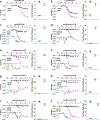TRUPATH, an open-source biosensor platform for interrogating the GPCR transducerome
- PMID: 32367019
- PMCID: PMC7648517
- DOI: 10.1038/s41589-020-0535-8
TRUPATH, an open-source biosensor platform for interrogating the GPCR transducerome
Abstract
G-protein-coupled receptors (GPCRs) remain major drug targets, despite our incomplete understanding of how they signal through 16 non-visual G-protein signal transducers (collectively named the transducerome) to exert their actions. To address this gap, we have developed an open-source suite of 14 optimized bioluminescence resonance energy transfer (BRET) Gαβγ biosensors (named TRUPATH) to interrogate the transducerome with single pathway resolution in cells. Generated through exhaustive protein engineering and empirical testing, the TRUPATH suite of Gαβγ biosensors includes the first Gα15 and GαGustducin probes. In head-to-head studies, TRUPATH biosensors outperformed first-generation sensors at multiple GPCRs and in different cell lines. Benchmarking studies with TRUPATH biosensors recapitulated previously documented signaling bias and revealed new coupling preferences for prototypic and understudied GPCRs with potential in vivo relevance. To enable a greater understanding of GPCR molecular pharmacology by the scientific community, we have made TRUPATH biosensors easily accessible as a kit through Addgene.
Conflict of interest statement
Competing Interests Statement
R.H.J.O., J.F.D., J.G.E., B.L.R., and R.T.S. are inventors of the TRUPATH technology, and could receive royalties. These relationships have been disclosed to and are under management by UNC-Chapel Hill.
Figures





References
MeSH terms
Substances
Grants and funding
LinkOut - more resources
Full Text Sources
Other Literature Sources
Research Materials
Miscellaneous

